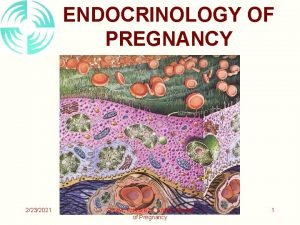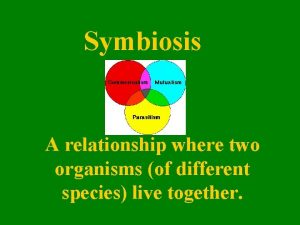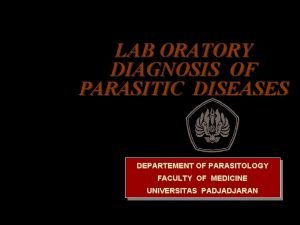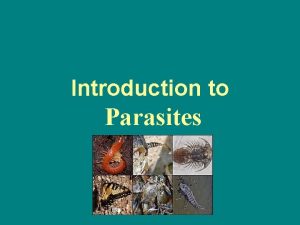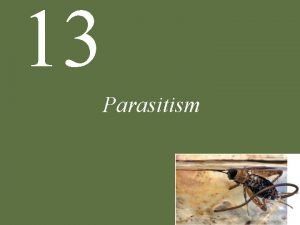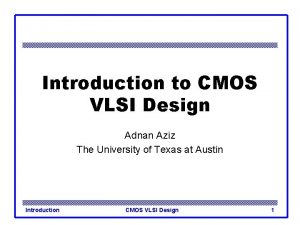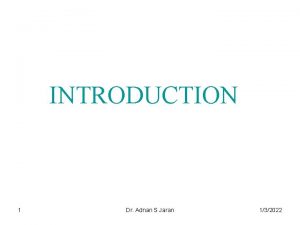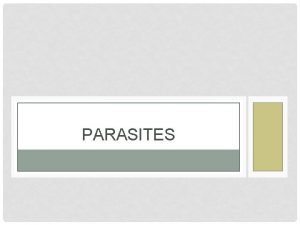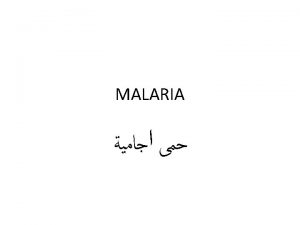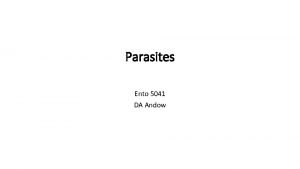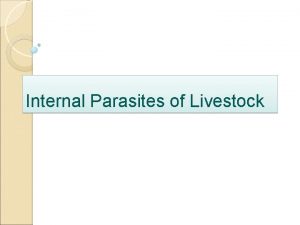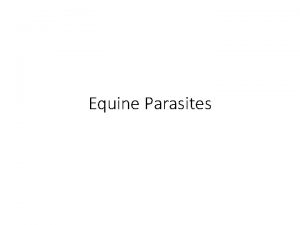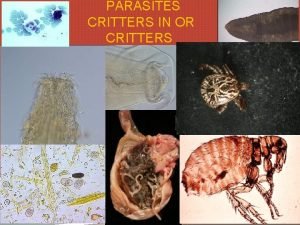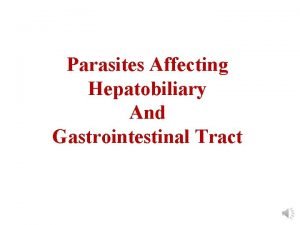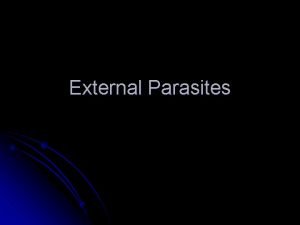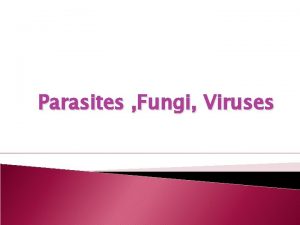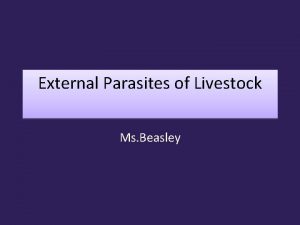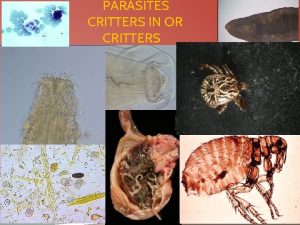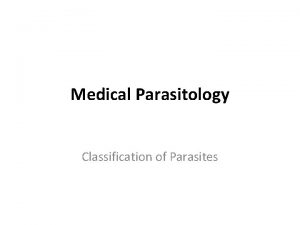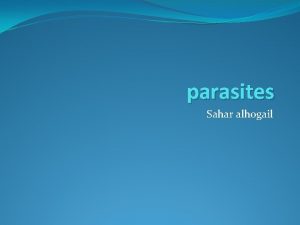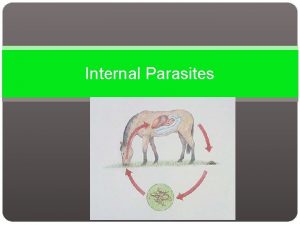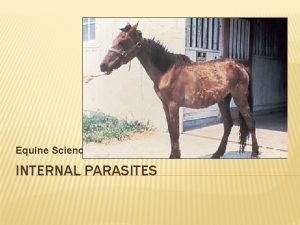INTRODUCTION 1 Dr Adnan S Jaran 2232021 Parasites






















- Slides: 22

INTRODUCTION 1 Dr. Adnan S Jaran 2/23/2021

Parasites are often described as occupying the third great environment, -aquatic, -terrestrial -parasitic, the body of another organism. So perhaps the first question about parasitism is how successful is it as a way of life? To some extent this depends on how you define parasitism, but all the major animal groups, except possibly the vertebrates (although some deep sea fish have parasitic males, and lampreys may be considered parasitic) have parasitic members, there are even parasitic cnidarians. It has been estimated that more than 50% of all known species are parasitic at some stage of their life cycle. Just as important as how many species of parasite are there, is how many plants and animals are themselves parasitized as. individuals and the answer must approach 100% 2 Dr. Adnan S Jaran 2/23/2021

Parasitism is a form of animal association, but can we define it more rigorously, how does our concept of parasitism differ from other associations, say prey/predator interactions 3 Dr. Adnan S Jaran 2/23/2021

Start with some definitions 4 Dr. Adnan S Jaran 2/23/2021

Symbiosis: means literally living together Coined in 1876 by De. Bary, to describe two species of organisms that lived together, with no implication regarding the length or outcome of the association. So symbiosis as originally conceived covered a range of intimate interactions between organisms-the most common ones being mutualism, commensalism and parasitism. So symbiosis was an overarching term, there has been a move to restrict symbiosis to a particular sort of association, where both partners are seen to benefit, but most modern literature has now returned to using symbiosis as an umbrella term for : organisms that live together. 5 Dr. Adnan S Jaran 2/23/2021

Mutualism: highly interdependent association, to the extent that the two associates cannot survive without one another. Example flagellate protozoa/termites or ruminants and rumen protozoa. In each case the protozoa have the enzymes that convert cellulose to glucose, the host provides a low redox potential environment. Two way benefit, no harm. 6 Dr. Adnan S Jaran 2/23/2021

Commensalism involves one way benefit, but as in the case of mutalism no harm is exerted in either direction. Clown Fish and sea anemone. The sea anemone provides protection against predators, the clown fish is highly evolved to survive the cnidarian nematocysts. Its external mucus layer is much thicker than that of related species and the chemical composition of clown fish mucus is different. Clown fish mucus consists largely of neutral polysaccharides and lacks the acidic sialic acid groups which trigger nematocyst discharge (although this makes the fish more susceptible to fungal infection). Commensalism usually involves a feeding relationship and generally does not involve metabolic independence. E. g. polychaete and hermit crabs. 7 Dr. Adnan S Jaran 2/23/2021

Parasitism. Classical definition - intimate relationship between two organisms in which one (the parasite) lives on, off or at the expense of the other (host). This implies that one of the partners benefits, the other is harmed. One problem with this simple definition is that harm is a very difficult thing to quantify, the same problem applies to the definition of mutualism and commensalism. In animal associations it is often assumed that one organism is benefiting or not without any real evidence. 8 Dr. Adnan S Jaran 2/23/2021

Rats, infected with the intermediate stages of a tapeworm called Spirometra grow larger than uninfected rats. The tapeworm larva produces an analogue of vertebrate growth hormone-is the growth boost harming the host or is it good for the host? Similarly many molluscs, when infected with the intermediate stages of Digenetic flukes develop thicker, heavier shells, which could be deemed an advantage. 9 Dr. Adnan S Jaran 2/23/2021

On closer investigation some of the classic examples of mutualism seem more like an armed standoff than mutual benefit. Given the right conditions many organisms which harbour symbiotic algae - like for example green hydra will digest the algae and carry on quite happily 10 Dr. Adnan S Jaran 2/23/2021

Many trees have associated with their roots fungal mycorrhiza. The fungi get organic nutrients from the plant via the phloem, and in nutrient poor soil the trees seem to benefit by increased nutrient uptake, particularly phosphate by the fungus. But if soil nutrient levels are good it appears much more like a parasitic invasion by the fungus with the tree attempting to wall off infected cells. Depending on external conditions, the association switches between mutualism and parasitism. 11 Dr. Adnan S Jaran 2/23/2021

So the simple definition of parasitism where one of the partners benefits and the other is harmed is not really adequate and also it does not really differentiate between a parasite and a predator or a parasite and a micro-predator. e. g. mosquito. 12 Dr. Adnan S Jaran 2/23/2021

In order to develop the concept of the host-parasite relationship different people have added to the classical definition that 'the parasite is metabolically or physiologically dependent on the host'. Or that there is 'genetic complementation between the parasite and its host'. That is that the parasite has lost the genetic ability to make certain vital metabolic intermediates and has to rely on the hosts genome for this or it may have to rely on the host genome to provide vital developmental stimuli. In extreme cases part of the parasites genome may have been lost and become integrated into that of the host. 13 Dr. Adnan S Jaran 2/23/2021

A more recent definition or perhaps description. of parasitism is that given by Crofton 1. 2. 3. 4. 5. 14 Ecological relationship between two different organisms, one designated the parasite, the other the host. The parasite is physiologically or metabolically dependent upon its host. Heavily infected hosts will be killed by their parasites. The reproductive potential of the parasite exceeds that of their hosts. There is an overdispersed frequency distribution of parasites within the host population. That is, the parasite population is not evenly distributed amongst the host population nor is it randomly distributed but clumped, so some hosts have a lot of parasites, most have very few. Dr. Adnan S Jaran 2/23/2021

• Parasitism is, like most other animal associations defined in terms of two different species, who form a regular association, although this seems sensible, and it does exclude consideration of the mammalian foetus as being parasitic upon its mother, there are some very interesting immunological parallels between the mechanisms the foetus uses to avoid being rejected by the immune response of its mother and the ways in which the parasites of mammals seek to avoid their hosts immune response. Also in a number of deep-sea fish, the males are tiny and become parasitic on the females, nothing is known about the physiological basis of this. 15 Dr. Adnan S Jaran 2/23/2021

Sometimes people add that the parasite is the smaller and the host the larger of the two organisms. This is generally true, although in some fish parasites, the plerocercoid stage of the tapeworm that lives in the body cavity of the fish can be heavier than the host. Size to a certain extent distinguishes parasites from predators, as predators are usually, but not always, larger than their prey. Any one parasite usually only infect a few different species of host during its life cycle (their are a few 4 host life cycles, no 5 host life cycles), this is in contrast to predators which usually eat a range of different prey species. 16 Dr. Adnan S Jaran 2/23/2021

Parasites have a higher reproductive potential than their hosts, this distinguishes parasites from predators. Predators have a lower reproductive potential than their prey, and are less numerous, whilst parasites have a higher reproductive potential and are more numerous. 17 Dr. Adnan S Jaran 2/23/2021

Physiological or metabolic dependence of the parasite on its host is central to most attempts to define parasitism. It does not of course distinguish parasitism from mutualism. Heavily infected hosts are killed, this introduces the concept of the cost to the host population of parasitism. 18 Dr. Adnan S Jaran 2/23/2021

No definition of parasitism is ever going to be completely satisfactory if we try hard enough we can always find an exception and there always going to be grey areas where parasitism, mutualism and commensalism overlap. 19 Dr. Adnan S Jaran 2/23/2021

• Useful definitions: • Ectoparasite– lives on surface. • Endoparasite– live inside host. • Mesoparasite– penetrates external openings - buccal cavity, cloaca, external ear. • Definitive host: animal harbouring the adult or sexually mature stage of the parasite • Intermediate host– required by parasite to complete its life cycle. Usually undergoes morphological or physiological change in it, and adulthood is not reached. 20 Dr. Adnan S Jaran 2/23/2021

• Paratenic host: optional transport host - no detectable morphological change in parasite • Vector: host that plays an active role in transmission, can be a definitive or an intermediate host. • Reservoir host: an animal that harbours a species of parasite that can be transmitted to and infect man. • Carrier: a host that harbours a parasite but exhibits no clinical signs or symptoms. 21 Dr. Adnan S Jaran 2/23/2021

Physiological or metabolic dependence of the parasite on its host is central to most attempts to define parasitism. It does not of course distinguish parasitism from mutualism. Heavily infected hosts are killed, this introduces the concept of the cost to the host population of parasitism. 22 Dr. Adnan S Jaran 2/23/2021
 2232021
2232021 Advanced stored procedure examples in sql server
Advanced stored procedure examples in sql server 2232021
2232021 2232021
2232021 2232021
2232021 2232021
2232021 2232021
2232021 2232021
2232021 2232021
2232021 2232021
2232021 Sis j
Sis j Example of mutualism
Example of mutualism Adnan gashi
Adnan gashi Charcot leyden crystals parasites
Charcot leyden crystals parasites Entamoeba histolytica common name
Entamoeba histolytica common name Adnan hafijur
Adnan hafijur Adnan akman
Adnan akman Enslaver parasites
Enslaver parasites Adnan çiftçibaşı
Adnan çiftçibaşı Adnan dhahir
Adnan dhahir Adnan aziz tengku faridah harris
Adnan aziz tengku faridah harris Djakovo concentration camp
Djakovo concentration camp Adnan akay
Adnan akay








